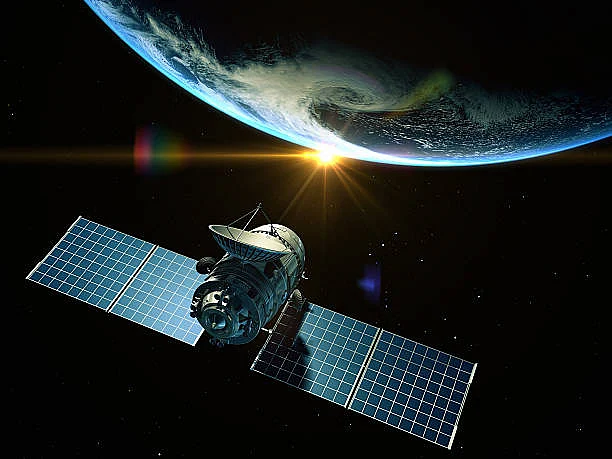From operating one of the world's largest solar farms, China is now aiming for a giant leap—building a 1-km-wide solar power station in space. The ambitious plan was revealed recently by Long Lehao, a rocket scientist and a member of the Chinese Academy of Engineering (CAE) during a lecture at the Chinese Academy of Sciences, according to South China Morning Post.
Expected to be the first space-based solar power (SBSP) station, it will collect energy from the sun through its components lofted to a geostationary orbit above Earth where its intensity is 10-times higher than that on Earth. This project will use super-heavy rockets and transmit the energy back to the planet without any interruptions, eliminating the inherent intermittency in Earth-based solar plants due to day-night cycles and changing weather conditions.
"The energy collected in one year would be equivalent to the total amount of oil that can be extracted from the Earth," said Lehao as cited in the report. “It is as significant as moving the Three Gorges Dam to a geostationary orbit 36,000km above the Earth,” he said. Situated on the Yangtze River, the dam constructed over 17 years with $25-35bn investment, generates approximately 100bn kilowatt hour (kWh) annually.
The facility for SBSP project was constructed by the Chongqing Collaborative Innovation Research Institute for Civil-Military Integration in China. There have been a series of power beaming experiments. In March 2021, a new committee for this purpose was established, according to UK-based Frazer-Nash Consultancy.
Referred to as the “Manhattan Project” of the energy sector, the project will require many launches. As per Live Science, Long and his team are working on the development of the Long March-9 (CZ-9) heavy-lift rocket which will have a lift capacity of at least 150 tonnes.
“They would have to develop a reusable version of LongMarch-9. If you can't make an economical launch vehicle which you can reuse, the project will not be possible,” Andrew Jones, a journalist tracking China’s space agency had told Financial Times in 2021. Jones expected some large rocket of this sort into low-Earth orbit to be launched in 2025 which will be capable of demonstrating a megawatt (MW) of power capacity around 2030 and 10,000-tonne space power plant in the orbit by 2050.
Since China's decision-making process is rather secretive, the exact plan and the investments in the project is hard to be known at this point. However, Chinese officials have indicated that they may have a demonstrator in low-Earth orbit soon.
Is It Feasible and Economical?
In theory, the solar power satellite is a massive spacecraft stationed in geostationary earth orbit, featuring large solar panels. The satellite collects sunlight, converts it into high frequency radio waves and beams to a rectifying antenna on the earth. The antenna converts the radio waves into electricity, and power is delivered into the grid.
John Mankins, ex-NASA physicist explained to FT in an interview, “A typical transmitter in the space would involve a transmission of about 2,000MW of electricity which is enough for about 1mn homes. The transmitter for that would be about one and a half kilometers in radius. And on the ground, 35,000km away, the receiver would be about 6km in diameter.”
Frazer-Nash Consultancy study, published in 2021 found that SBSP is technically feasible and affordable. It has good grid integration characteristics, and is resilient and secure. It can be scaled to contribute to the abundant clean energy throughout the world, beaming power to other nations either as export or as development aid or to support disaster-hit regions.
For economical production of the technology, two primary capabilities are required: robotic in-orbit assembly and a low cost reusable space transportation infrastructure, the study stated. Although both of these are immature currently but are rapidly developing. Due to lowering down of space launch costs in recent years and the availability of new highly modular solar power satellite designs, SBSP has become feasible.
Other Countries Advancing in SBSP Development
Around the world, efforts are on for building space-based solar satellite arrays. According to the study conducted by Frazer-Nash Consultancy, Japan has been undertaking well-funded research into SBSP since the past few decades. The ambition is enshrined in its Basic Space Law, and Japan Aerospace Exploitation Agency (JAXA) has a roadmap to commercial SBSP. The country has made significant progress in this area with the launch of a small, proof of concept satellite scheduled this year to assess its feasibility.
The US, on the other hand, has been pursuing defense research with $180mn programme led by a defense company Northrop Grumman and the US Air Force Research Lab to develop and demonstrate the technology. In the UK, companies like Space Solar plan to introduce a scalable, economical and fully renewable energy technology to space. Other countries that have shown interest in SBSP includes South Korea, Australia and Canada.
In the pursuit of achieving net-zero emissions and industrial decarbonisation, these advancements mark significant progress. SBSP, especially China's project, offers hope for a future where renewables dominate the global energy mix—and perhaps even replace fossil fuel some day. But navigating through the web of challenges to make this a reality will take time. To accelerate the transition more countries will need to develop similar projects and collaborate on scaling up this technology.






























